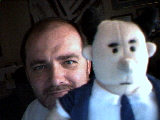Since starting this blog I have resisted the temptation to rant about past jobs and the people I have encountered in these positions. Many blogs are a place for lots of sour grapes, or just living in the past to assign blame. But a recent article in Business Week, Bad Habits That Can Hold You Back, struck such a chord with me that I feel compelled to devote some words to it in this posting.
Below are the twenty bad habits of ineffectual leaders identified in the BW article.
Winning Too Much: The need to win at all costs and in all situations—when it matters, when it doesn’t, and when it’s totally beside the point.
Adding Too Much Value: The overwhelming desire to add our two cents to every discussion.
Passing Judgment: The need to rate others and impose our standards on them.
Making Destructive Comments: The needless sarcasms and cutting remarks that we think make us sound sharp and witty.
Starting with “No,” “But,” or “However”: The overuse of these qualifiers, which secretly say to everyone, “I’m right. You’re wrong.”
Telling the World How Smart We Are: The need to show people we’re smarter than they think we are.
Speaking When Angry: Using emotional volatility as a management tool.
Negativity: The need to share our negative thoughts, even when we weren’t asked.
Withholding Information: The refusal to share information in order to maintain an advantage over others.
Failing to Give Proper Recognition: The inability to praise and reward.
Claiming Credit We Don’t Deserve: The most annoying way to overestimate our contribution to any success.
Making Excuses: The need to reposition our annoying behavior as a permanent fixture so people excuse us for it.
Clinging to the Past: The need to deflect blame away from ourselves and onto events and people from our past; a subset of blaming everyone else.
Playing Favorites: Failing to see that we are treating someone unfairly.
Refusing to Express Regret: The inability to take responsibility for our actions, admit we’re wrong, or recognize how our actions affect others.
Not Listening: The most passive-aggressive form of disrespect for colleagues.
Failing to Express Gratitude: The most basic form of bad manners.
Punishing the Messenger: The misguided need to attack the innocent, who are usually only trying to protect us.
Passing the Buck: The need to blame everyone but ourselves.
An Excessive Need to Be “Me”: Exalting our faults as virtues simply because they exemplify who we are.
I once had a boss that exhibited nearly all of these bad behaviors. It was one of the most debillitating experiences of my professional career. No matter how hard I worked or what I accomplished, I remained in the shadow of this person's ego and indifference. Yet I continued to work for this person because I labored under a naïve notion that he would be found out by the company and be summarily dismissed or demoted. My mistake was to not move onward as soon as I recognized these symptoms. I enjoyed the work I was doing but ignored the effect this boss was having on my personal and professional life. To this day my family and I cringe whenever this person's name is mentioned.
If you see your boss or company management exhibiting the behaviors above, it is time for you to start looking around for something better.
Saturday, December 30, 2006
Tuesday, December 26, 2006
USPTO Patent Performance in 2006
Source: <http://www.uspto.gov/web/offices/com/speeches/06-73.htm>


"Patent examiners completed 332,000 patent applications in 2006, the largest number ever, while achieving the lowest patent allowance error rate -- 3.5% -- in over 20 years. At 54%, the patent allowance rate was also the lowest on record. [See Figure below] Patent allowance rate is the percentage of applications reviewed by examiners that are approved."

"The USPTO received in excess of 440,000 patent applications in 2006, a record number. To help meet the demand, the agency hired a record 1,218 patent examiners, exceeding its goal by more than 200 people. To support this dramatic hiring increase, the USPTO replaced its one-on-one training model with a university approach for new hires. This allowed the agency to deliver comprehensive training to new examiners, while more experienced examiners and supervisors focused on quality examination. The agency will continue to hire over 1,000 patent examiners each year for the next five years. Even so, the volume of applications will continue to outpace the agency's capacity to examine them. USPTO continues to look for ways, beyond hiring, to reduce the backlog, while maintaining examination quality. "
Working at home: "The first 500 patent examiners began working from home four days a week, using a hoteling program to book office space the one day a week they are in the office. The agency expects that an additional 500 examiners will be added to those already working from home each year for at least the next five years."
From the numbers above, we see that the USPTO is receiving more patent applications than they are completing, i.e., the USPTO is completing one application for every 1.32 applications received. From 1997 to 2006, the number of patent applications being filed have increased by 87 percent. In 2006, the backlog of patent applications exceeded 700,000! This backlog increased the USPTO pendency (see figure below) for taking action on the submitted application.

As shown in the Figure above, USPTO first action pendency is now exceeding 22 months. Average first action pendency measures the average time in months from filing until an examiner’s initial determination is made of the patentability of an invention. Indeed, some business method patent applications have taken over ten years before issuance!
Subscribe to:
Posts (Atom)
